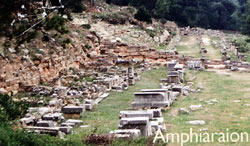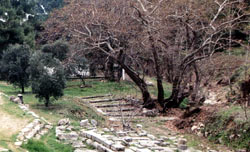
|
Amphiaraion: Attica's Ancient Healing Center |
Nestled at the bottom of a gentle ravine surrounded by a pine forest that has somehow survived the annual infernos that sweep the hills above Oropos, the shrine of Amphiaraion features on few tourist itineraries. A small, mostly Hellenistic site to a now forgotten minor god, it was nevertheless chosen with the unerring sense of place so evident in virtually every ancient holy spot in this country. Though it takes less than 30 minutes to drive there from Kifissia, I hadn’t visited Amphiaraion since that sultry June afternoon some twenty years ago when we maneuvered a harpsichord down the stony path to its theater to give an illicit performance of Dido and Aeneas. While we were warming up, friends and fans who had caught wind of this crypto Athens Singers concert trickled in, arranging their cushions, picnic baskets and demijohns on the hummocks and clumps of stone where the seats should have been. After all, no audiences had sat there for at least seventeen hundred years. As we joined our voices to the tinkles and thumps of the harpsichord, Purcell’s tunes woke up the nightingales, owls and crickets. Their choruses almost drowned us out, and in the end they stole the show. We lingered to listen to them until the midsummer moon rose and the guard had to go home to his wife. Now a formidable fence encircles the site and the guard is no longer amendable to such infringements, but the shrine has not lost its magic. And the clearing away of some underbrush has made it seem larger, leaving more to explore. It was dedicated to Amphiaraos, a Bronze Age king of Argos whose ability to interpret dreams inspired widespread worship by the Classical era. Amphiaraos was one of the seven kings who led the attack on Thebes after the Oedipus scandal. He went most reluctantly since he had foreseen his own death; and die he did, though not on the battlefield. Rather than let him be slain by a Theban warrior,
Hundreds of years later, the Greeks who held great store by oracles erected several shrines to the legendary seer-hero, and by far the most famous was the one near Oropos, from whose spring he was said to have reappeared as a god. Today there are few traces of that very ancient port city at the modern ferry landing of Skala Oropou, but even in Pausanias’s time, there was nothing “great to record.” Which was probably why the Oropiotes were so proud of their one attraction, the Amphiaraion, a big money maker. Its prestige and profits surely whetted Athenian appetites for acquisition, for both town and sanctuary were coveted by Athens and Boeotia, who struggled over them for generations. The shrine was founded in the late 5th century BC and already by the 4th century it was a thriving spa/religious center with a temple, a long colonnade, baths, hostels, shops and, of course, the theater. Now as then a stream runs through it, separating the show-case buildings to the left of the entrance from the smaller residential and commercial ones on the right. The jumbled foundations of the latter have only recently been disentangled from the thick woods and underbrush that concealed them in the days when I used to make my pilgrimages. In fact, we had no inkling of their presence then, but loved to scramble up the opposite bank of the stream to admire the state of the art technology of the Hellenistic era – a water clock. It’s a little jewel. A rectangular ‘box’ about 2 meters deep set inside a larger square equipped with a small flight of stairs, it is a perfect example of the stone cutter’s art, as well as being a timepiece more reliable than a sundial. Perhaps it was used to schedule cures, sacrifices or events at the games. Time in those days was refreshingly imprecise, with no onus attached to not being ‘on time’ or ‘in’ it. For about six hundred years the sanctuary was a favourite recourse for people seeking a solution to a problem or relief from an illness. The procedure was simple. After paying the entrance fee, the patient sacrificed a ram on the altar, which Pausanias says was divided up into sections, each sacred to a diverse group of deities, ranging from Jason and Hercules, to Zeus, Apollo, Athena and Aphrodite, plus Pan, the nymphs and two other river gods in addition to Amphiaraos. What a luxury to be able to take one’s pick. The pilgrim, wrapping himself up in the fleece of the ram, would then go to sleep, hoping for a portentous dream, in the colonnade, which was lined with marble benches. After interpretation of the dream and any further treatment, which usually included baths in the miraculous waters, it was customary to thank the gods by throwing gold and silver coins into the stream. Needless to say, the priests encouraged this practice; they regularly fished them out and melted them into material for ex votos which they could sell at a good profit. The altar must have resembled the icon of the Virgin Mary in Tinos, so bedecked was it with symbolic images of children or afflicted body parts – legs, arms, eyes, breasts. Many such offerings have been found, made of both clay and precious metals. Like many religious centers of the ancient world, the Amphiaraion celebrated festivals in the form of games, the Lesser Games annually, and the Greater Games every five years. It is hard to imagine the secluded spot ringing with cries of athletes, actors, dancers, musicians, poets, spectators, and the inevitable hawkers of souvenirs and refreshments. The space between the stream and the stoa, where the spectators sat, barely seems large enough to have served as a stadium, and the wrestling, boxing, pentathlon and other competitions would have had to have been squeezed in there too. At least they did not try to hold the chariot races in the sanctuary proper, the hippodrome was located somewhere on the hill above. After the sports events, the theater would fill up for plays and poetry readings. It must have been bursting to capacity since it only held 300 seats, plus five beautifully carved marble thrones placed in the orchestra for VIPs or priests. By the 1st century BC these would have been reserved for Roman dignitaries. The Oropiotes did not welcome the new world order, but because etiquette demanded that they erect statues to their new rulers at great expense, they resorted to recycling. To the left of the entrance to the sanctuary is a row of more than thirty pedestals for statues, on How to get there To get to Amphiaraion, take the national road north, turn right at Malakassa for Markopoulo, and right again at the sign for Sanctuary of Amphiaraos (3 km) and Kalamos. The KTEL buses for Markopoulo/Kalamos leave from Mavrommateon Street near the Archaelogical Museum in Athens (tel: 210 8213202), but do not pass the site, so be prepared for a 4 km walk along a tree-lined road, parts of which are disagreeably decorated with litter and rubble. Where to eat The peaceful, usually empty site is ideal for picnicking but if you’d prefer a taverna lunch, backtrack to the Markopoulo road and head down to the village. Where the road widens is a cluster of shops, including D. Tsakona’s psistaria, where lambchops will be grilling on the coals. The food is the classic bare minimum – meat, salad, horta, feta, and genuine fried potatoes – but it’s well prepared, the wine is good and it’s very cheap. There are several fish tavernas at Skala Oropos and Agii Apostoli, but for a less hectic ambience, drive north along the coast to Dilessi. This is by far the most attractive of the seaside summer colonies, with a handful of traditional fish tavernas and a landscaped, car-free promenade on the water’s edge. Note Sadly, the fire of 2000 ravaged the trees on the upper hillsides, while the heavy snow of January 2002 caused further damage, uprooting and breaking pines and olives. But apart from losing two large pines, the sanctuary itself remains unscathed. The Santuary is open daily from 8 am to 2:30 pm, except Mondays. There is a fee which is waived on Sundays and holidays. |
|


